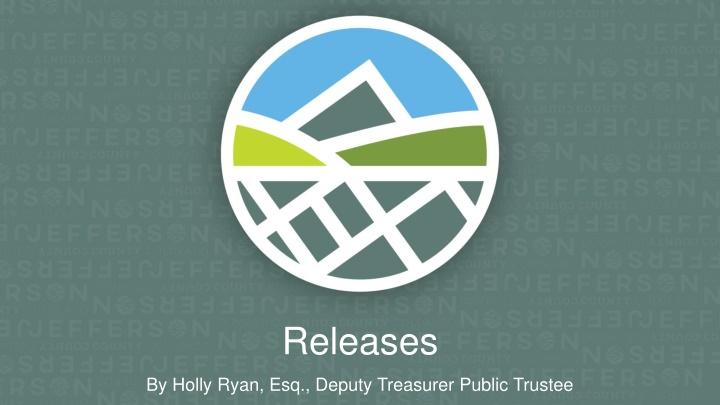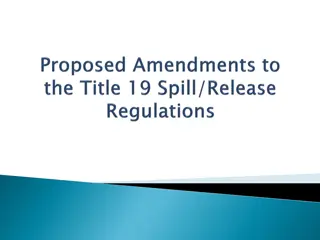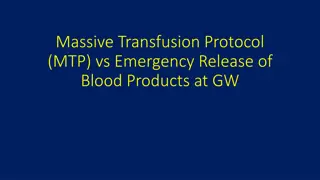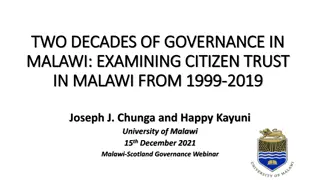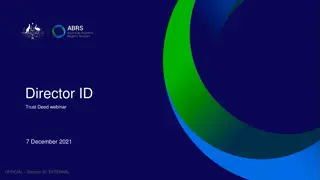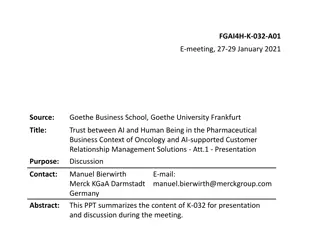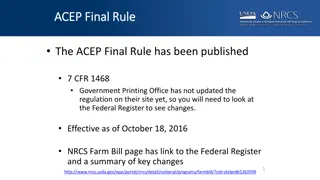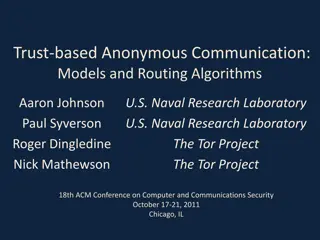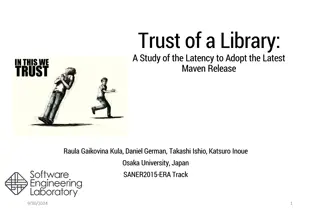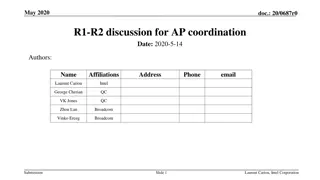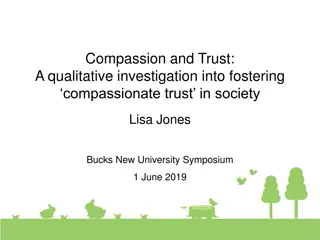Release of Deed of Trust
A Release of Deed of Trust is a document signed by the current holder to remove a lien on real estate. Learn about Deeds of Trust, full vs. partial release, and what to do if the Public Trustee is not listed.
Download Presentation

Please find below an Image/Link to download the presentation.
The content on the website is provided AS IS for your information and personal use only. It may not be sold, licensed, or shared on other websites without obtaining consent from the author.If you encounter any issues during the download, it is possible that the publisher has removed the file from their server.
You are allowed to download the files provided on this website for personal or commercial use, subject to the condition that they are used lawfully. All files are the property of their respective owners.
The content on the website is provided AS IS for your information and personal use only. It may not be sold, licensed, or shared on other websites without obtaining consent from the author.
E N D
Presentation Transcript
Releases By Holly Ryan, Esq., Deputy Treasurer Public Trustee
What is a Release of Deed of Trust? A Release of Deed of Trust is a document that is signed and executed by the current holder of a Deed of Trust. The document must be signed and acknowledged before a Notary of Public. The release form is submitted to the Public Trustee s Office in the county where the property is located. The purpose of the Release is to remove a lien that was placed on real estate by the recordation of Deed of Trust. The Release will either release all encumbrances (Full Release) or partial encumbrances (Partial Release).
What is a Deed of Trust? A Deed of Trust is a third-party instrument used to create voluntary liens in real estate. The parties to a Deed of Trust are the Grantor, who is the property owner; the Beneficiary, who is the lender; and the Public Trustee, who holds certain powers of foreclosure and release. It is recorded (by the County Clerk and Recorder) and when recorded, a Deed of Trust creates a lien against the Grantor s real property. When the terms of the Deed of Trust have been satisfied, a request of Release of Deed of Trust must be recorded to remove the lien from the real property.
Full v. Partial Release Full means that the current holder is releasing their lien from the entirety of the real property. A legal description should NOT be listed on the release. Partial means that the current holder is releasing only a portion of their lien from the real property s legal description. Common is situations where a Deed of Trust encumbers multiple lots, blocks, parcels, schedules, etc.
Example Partial Release
What if the Deed of Trust lists anyone other than a Public Trustee? If the Public Trustee is not listed as the Trustee on the face of the Deed of Trust, the holder will need to submit a Release of Lien as Evidenced by Deed of Trust. The exception to this rule is that all Colorado Public Trustee s are interchangeable for each other. So, if the Deed of Trust names the wrong Public Trustee but the property is located in your county you can accept and process the release request.
Release of Lien as Evidenced by Deed of Trust
What about liability? CRS 38-39-102(6) states: The public trustee shall have no liability to any person, and no action may be commenced against the public trustee, as a result of issuing a release or partial release of a deed of trust under subsection (3) of this section, unless such action is commenced within six years from the date of the recording of such release or partial release or within the period of time prescribed by any statute of limitation of this state in which a suit to enforce payment of the indebtedness or performance of the obligation secured by said deed of trust may be commenced, whichever is less. Nothing in this article shall be construed to waive immunity of a public trustee that is provided in sections 24-10-101 to 24-10-120, C.R.S.
Processing Fees One Page Release Total Fee: $28.00 Two Page Release Total Fee: $33.00 ($5.00 for each additional page) Three Page Release Total Fee: $38.00 ($5.00 for each additional page) Out of the total fee paid, the Public Trustee receives $15 and the remaining balance is paid to the Clerk and Recorder.
Requirements for a Release of Deed of Trust Requirements for a Release of Deed of Trust are described in Colorado Revised Statutes 38-39-102 and must be precisely followed by the Public Trustee in the county in which the real property is located.
With v. Without Production What does this mean? With means that the current holder does not qualify to e-file the Release. The exception to this rule is if they e-file using box 3D on the without release. With filers are required to submit the Original Release accompanied by the Original Note (evidence of debt), Copy of the Recorded Deed of Trust and payment for the service. Lost Original Note means the submitter has to purchase a replacement bond for 1.5 times the original value. The cost varies from $100-$10,000+ Without means that the current holder does qualify under the statute to e-file the Release. Submitters will use Simplifile or CSC
WITH production form
Filling out the WITH production form Make sure you have the right form. There are two different types of releases. Release form must be printed on legal size paper. Public Trustee Section: The county listed is where the property is located. Legal Description Section: If you marked that the release is a PARTIAL RELEASE** at the top of the document, you are required to provide the legal description in the large space provided below this section. If the legal description is too large for this section, please attach it as a second page to the release form. **If the release is a FULL RELEASE, you do NOT need the legal description to be included on the document. Mark one of the boxes that says if the release form is a FULL or PARTIAL release. First line: Put the current day that you are filling out the release form. You put this on the first line that says date . Second line: Put the name(s) of the original grantor(s) (Borrower(s)). Legal Description Section: If you marked that the release is a PARTIAL RELEASE** at the top of the document, you are required to provide the legal description in the large space provided below this section. If the legal description is too large for this section, please attach it as a second page to the release form. **If the release is a FULL RELEASE, you do NOT need the legal description to be included on the document. Third line: Put the address of the original grantor(s) (Borrower(s)). If the address is unknown*, check the box that address is unknown. *This means that the release form will be sent to the address at the top of the release form where it states WHEN RECORDED RETURN TO: after it has been recorded by the Clerk and Recorder. Name and Address of Current Holder of the Evidence of Debt: You will list the information for the original beneficiary/lender. Fourth line: Put the name or names of the original beneficiary (Lender). Fifth line: Put the Date the Deed of Trust was executed/signed. This will likely be on the first page Deed of Trust. Name, Title and Address of Officer, Agent, or Attorney of Current Holder: You will list the information for the person signing the release on behalf of the beneficiary/lender. Sixth & Seventh lines: You will put the recording date and reception number for the Deed of Trust. This information will normally be on the first page Deed of Trust and may have a bar code either above or below the recording information. Put the date the recording was on the line that states Date of Recording . The reception number will go on the line that states Recording Information . Signature: The Beneficiary/Lender signs on the first line. Two lines have been provided if needed. Notary Section: Finally, the release needs to be notarized by a notary.
Example of full WITH release
Lost Original Note? If a holder is unable to locate the original note they will need to purchase a Lost Instrument Bond at 1 times the original face value of the Note. The Lost Instrument Bond should be recorded along with the release. Every page of the Lost Instrument Bond, including the back of double sided copies will count as an additional $5.00 to record and must be included in your payment. As of August 11, 2022, if a holder has lost the Original NOTE and does not want to purchase a Lost Instrument Bond, they can now use the WITHOUT Production Release Form marking 3d, indemnifying the Public Trustee to have the release processed. Marking 3d requires that the form be e-filed by a title company or any e-filing subscription user.
Filling out the WITHOUT production form Public Trustee Section: This is where you will list the county where the property is. All properties in Jefferson County should be filled in with Jefferson County on the blank line. Legal Description Section: If you marked that the release is a PARTIAL RELEASE** at the top of the document, you are required to provide the legal description in the large space provided below this section. If the legal description is too large for this section, please attach it as a second page to the release form. Qualified Holder Section: 3a, 3b, 3c & 3d: Mark 3a if you are the holder of the evidence of debt as specified in CRS 38-3-102(3)(a). Mark 3b if you are holder of the evidence of debt as specified in CRS 38-3-102(3)(a) and are requesting the release by also delivering a Corporate Surety Bond (Lost Instrument Bond) to the Public Trustee s office. Mark 3c if you are title company licensed and qualified in the State of Colorado. Mark 3d if you are the holder of the evidence of debt as specified in CRS 38-3-102(3)(a) but submitted the request through a title company or e-filing entity. Mark one of the boxes that says if the release form is a FULL or PARTIAL release. First line: Put the current day that you are filling out the release form. You put this on the first line that says date . Second line: Put the name(s) of the original grantor(s) (Borrower(s)). Third line: Put the address of the original grantor(s) (Borrower(s)). If the address is unknown*, check the box that address is unknown. *This means that the release form will be sent to the address at the top of the release form where it states WHEN RECORDED RETURN TO: after it has been recorded by the Clerk and Recorder. Fourth line: Put the name or names of the original beneficiary (Lender). Fifth line: Put the Date the Deed of Trust. This will likely be on the first page Deed of Trust . Sixth & Seventh lines: You will put the recording date and reception number for the Deed of Trust. This information will normally be on the first page Deed of Trust and may have a bar code either above or below the recording information. Put the date the recording was on the line that states Date of Recording . The reception number will go on the line that states Recording Information .
"WITHOUT production form
